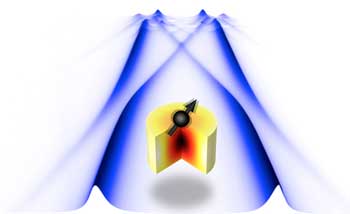| Jan 14, 2021 |
Scientists tame photon-magnon interaction
(Nanowerk News) Working with theorists in the University of Chicago’s Pritzker School of Molecular Engineering, researchers in the U.S. Department of Energy’s (DOE) Argonne National Laboratory have achieved a scientific control that is a first of its kind. They demonstrated a novel approach that allows real-time control of the interactions between microwave photons and magnons, potentially leading to advances in electronic devices and quantum signal processing (Physical Review Letters, "Floquet Cavity Electromagnonics").
|
|
Microwave photons are elementary particles forming the electromagnetic waves that we use for wireless communications. On the other hand, magnons are the elementary particles forming what scientists call 'spin waves' — wave-like disturbances in an ordered array of microscopic aligned spins that can occur in certain magnetic materials.
|
 |
| Tuned photon-magnon interactions. The team’s device is in the center. Arrow indicates direction of spin excitation for magnons. The purplish shroud represents reflectance measurements. The separated darker lines on each side that intersect at the top indicate tunable strong photon-magnon coupling. (Image: Argonne National Laboratory)
|
|
Microwave photon-magnon interaction has emerged in recent years as a promising platform for both classical and quantum information processing. Yet, this interaction had proved impossible to manipulate in real time, until now.
|
|
“Before our discovery, controlling the photon-magnon interaction was like shooting an arrow into the air,” said Xufeng Zhang, an assistant scientist in the Center for Nanoscale Materials, a DOE User Facility at Argonne, and the corresponding author of this work. "One has no control at all over that arrow once in flight.”
|
|
The team’s discovery has changed that. "Now, it is more like flying a drone, where we can guide and control its flight electronically,” said Zhang.
|
|
By smart engineering, the team employs an electrical signal to periodically alter the magnon vibrational frequency and thereby induce effective magnon-photon interaction. The result is a first-ever microwave-magnonic device with on-demand tunability.
|
|
The team’s device can control the strength of the photon-magnon interaction at any point as information is being transferred between photons and magnons. It can even completely turn the interaction on and off. With this tuning capability, scientists can process and manipulate information in ways that far surpass present-day hybrid magnonic devices.
|
|
“Researchers have been searching for a way to control this interaction for the past few years,” noted Zhang. The team’s discovery opens a new direction for magnon-based signal processing and should lead to electronic devices with new capabilities. It may also enable important applications for quantum signal processing, where microwave-magnonic interactions are being explored as a promising candidate for transferring information between different quantum systems.
|

